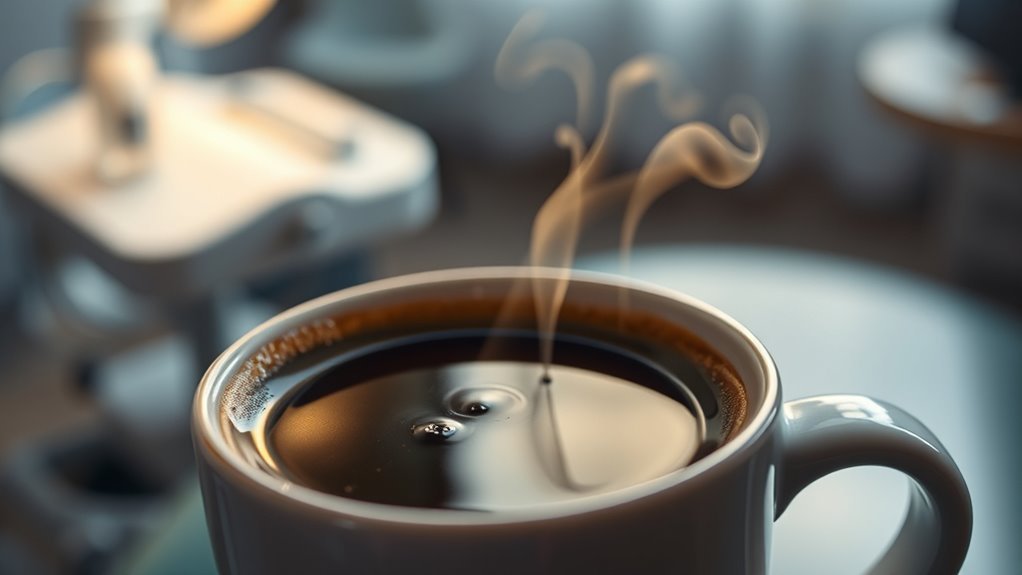Can I Drink Room Temp Coffee After Tooth Extraction
Yes, you can drink room temperature coffee after tooth extraction, as it’s gentler on healing tissues compared to hot beverages. However, be mindful of caffeine, which can elevate anxiety and potentially slow your recovery. Stick to soft, nutritious foods and focus on hydration for ideal healing. If you experience any unusual pain or complications, consult your dentist promptly. For more insights on post-extraction care, including dietary recommendations and warning signs, keep exploring the topic.
Understanding Tooth Extraction Recovery

When you undergo a tooth extraction, it’s important to understand the recovery process to guarantee proper healing. Effective pain management is essential during this time. Over-the-counter pain relievers can help, but always follow your dentist’s recommendations. You might experience swelling and discomfort, so don’t hesitate to reach out for advice if needed.
Dietary adjustments are also significant. Stick to soft foods like yogurt, applesauce, and mashed potatoes for the first few days. Avoid anything crunchy or hard that could irritate the extraction site. Staying hydrated is critical, but be cautious with your beverage choices. Room temperature drinks are generally safer than hot or cold options. By paying attention to these aspects, you can promote a smoother recovery and regain your freedom sooner.
The Role of Temperature in Post-Extraction Healing
Temperature plays a significant role in the healing process after a tooth extraction. Understanding how temperature sensitivity affects your recovery can help guarantee peak healing. Here are three key points to take into account:
Temperature is crucial for healing after a tooth extraction; understanding its effects can enhance your recovery.
- Cold Foods and Drinks: While cold items can numb discomfort, they may also exacerbate sensitivity.
- Warm Items: Room temperature or warm beverages are ideal, as they provide comfort without irritating the extraction site.
- Avoid Hot Items: Consuming hot foods or drinks too soon can disrupt the healing process and cause pain.
Effects of Caffeine on Healing

Although caffeine is often associated with increased alertness and energy, its effects on the healing process after a tooth extraction can be more complex. For some individuals, caffeine sensitivity can heighten anxiety or discomfort, potentially impacting your overall recovery experience. If you’re prone to these sensitivities, consuming caffeinated beverages may slow your healing pace by causing increased heart rate or elevated blood pressure. Additionally, caffeine can lead to dehydration, which may further hinder the healing process. It’s essential to monitor how your body responds to caffeine during this time. If you experience adverse effects, consider reducing your intake to support a smoother recovery. Always consult with your dentist for personalized advice tailored to your specific situation.
Benefits of Room Temperature Beverages
Room temperature beverages can be particularly beneficial during your recovery. They’re gentle on healing tissues, which is essential after a tooth extraction, and can enhance hydration absorption. Additionally, you might find that these beverages offer a more pronounced flavor experience, making your drinks more enjoyable.
Gentle on Healing
When considering what to drink after a tooth extraction, opting for room temperature beverages can be particularly beneficial for your healing process. These drinks minimize discomfort and support your oral hygiene. Here are three key benefits of room temperature beverages:
- Gentle on the Extraction Site: They’re less likely to irritate sensitive areas, allowing for smoother healing.
- Promotes Gentle Flavors: Room temperature drinks often have milder tastes, making them easier to consume without causing any pain.
- Reduces Swelling Risks: Extreme temperatures can exacerbate swelling; room temp options help maintain comfort during recovery.
Choosing the right beverages can greatly impact your healing journey, so consider these factors for a smoother recovery.
Improved Hydration Absorption
As you recover from a tooth extraction, drinking room temperature beverages can greatly enhance your hydration absorption. Unlike cold drinks, room temperature options are easier for your body to process, promoting effective hydration methods. When your body isn’t busy trying to warm up a chilled beverage, it can focus on absorbing fluids more efficiently. This is particularly important during your recovery, as staying hydrated supports healing and reduces discomfort. Utilizing absorption techniques that favor room temperature drinks can be beneficial, allowing your body to utilize the nutrients and fluids without added strain. By choosing room temperature beverages, you’re not only ensuring better hydration but also facilitating a smoother recovery experience. Remember, hydration is key to feeling your best post-extraction.
Enhanced Flavor Experience
While many people associate cold drinks with refreshment, opting for room temperature beverages can greatly enhance your flavor experience. When it comes to coffee tasting, enjoying it at room temperature allows you to fully appreciate its unique flavor profile. Here are three benefits of room temperature beverages:
- Enhanced Aroma: Room temperature coffee releases more aromatic compounds, intensifying your tasting experience.
- Balanced Flavor: Warmer coffee enables you to detect subtle notes and complexities in the flavor profile that cold drinks might mask.
- Smoother Texture: The viscosity of room temperature coffee can provide a more satisfying mouthfeel, making each sip enjoyable.
Recommendations for Post-Extraction Diet
Following a tooth extraction, it’s crucial to choose your diet carefully to promote healing and avoid complications. Focus on soft, nutrient-rich post-extraction foods that won’t irritate the extraction site. Mashed potatoes, applesauce, and yogurt are excellent choices, as they’re easy to consume and soothing. Incorporating healing smoothies can be beneficial, too; blend fruits, spinach, and protein powder for a nutritious treat that’s gentle on your mouth. Avoid crunchy, spicy, or hot foods, as they can disrupt the healing process. Remember to stay hydrated, but opt for cool or room temperature beverages to minimize discomfort. By selecting the right foods, you’ll support your recovery and enjoy a smoother healing journey.
Alternatives to Coffee During Recovery

During your recovery from a tooth extraction, you might want to explore alternatives to coffee, especially since caffeine can potentially irritate your healing gums. Here are some soothing options to contemplate:
Explore soothing alternatives to coffee during your recovery from tooth extraction to support your healing gums.
- Herbal Teas: Opt for caffeine-free herbal teas like chamomile or peppermint. They can provide comfort and hydration without aggravating your gums.
- Smoothie Alternatives: Blend up a nutrient-rich smoothie using soft fruits like bananas or avocados. Adding yogurt can enhance creaminess while being easy on your mouth.
- Warm Broths: A gentle, warm broth can be both nourishing and hydrating, offering essential nutrients without the risk of irritation.
These alternatives can help keep you comfortable while you heal, allowing you to enjoy flavorful beverages without compromising your recovery.
Signs of Complications to Watch For
After a tooth extraction, it’s essential to monitor your recovery for any signs of complications. You should be alert for increased pain levels, persistent bleeding, or notable swelling and inflammation. Recognizing these symptoms early can help you seek timely medical attention if needed.
Increased Pain Levels
While it’s normal to experience some discomfort after a tooth extraction, increased pain levels can signal potential complications that require attention. You should monitor your pain management closely and be aware of any changes in your discomfort levels. Here are three signs that may indicate a problem:
- Sharp or throbbing pain that worsens over time, rather than gradually improving.
- Pain that radiates to other areas, such as your jaw, neck, or ear, which may signify an infection.
- Persistent pain after the initial few days, especially if accompanied by swelling or fever.
If you notice any of these signs, it’s important to consult your dentist to guarantee proper recovery and address any complications promptly.
Persistent Bleeding Issues
If you find yourself dealing with persistent bleeding after a tooth extraction, it could indicate complications that need addressing. Effective bleeding management is vital during your recovery timeline. While some oozing is normal, continuous bleeding beyond a few hours may signal issues like a dry socket or inadequate blood clot formation. Keep an eye out for any changes in the bleeding’s intensity or color, as these can provide important clues about your healing process. If bleeding doesn’t subside with gentle pressure or if it worsens, don’t hesitate to contact your dentist. Timely intervention can help guarantee a smoother recovery and prevent further complications, allowing you to regain your freedom to enjoy life without discomfort.
Swelling or Inflammation
Swelling or inflammation around the extraction site can be a normal part of the healing process, but it’s essential to monitor these symptoms closely. While some degree of swelling is expected, excessive inflammation could indicate complications. Effective swelling management and inflammation control are key to a smooth recovery. Here are three signs to watch for:
- Severe Swelling: If swelling worsens after the first 48 hours, it may require attention.
- Pain Increase: An escalation in pain can signal an infection or other issues.
- Discoloration: Unusual redness or discoloration around the site can indicate inflammation that needs evaluation.
If you notice any of these signs, consult your dentist promptly to guarantee proper healing.
Hydration and Its Importance in Healing
Staying properly hydrated is essential for your recovery after a tooth extraction, as it helps facilitate the healing process. Hydration plays an important role in reducing inflammation and promoting tissue repair. To guarantee ideal recovery, follow these hydration tips: drink plenty of water throughout the day, and avoid sugary or caffeinated beverages initially, as they can dehydrate you. You might also consider incorporating electrolyte-rich drinks to replenish critical nutrients. Remember, the healing significance of hydration cannot be overstated; it not only enhances your body’s ability to recover but also supports overall well-being. Prioritizing hydration will help you feel better faster, allowing you to enjoy your favorite beverages again with peace of mind.
When to Reintroduce Hot Beverages

After confirming proper hydration to support your healing, it’s important to contemplate when you can safely reintroduce hot beverages like coffee. Generally, you’ll want to wait at least 48 hours post-extraction before considering hot drinks. This timeframe allows your body to start healing without the risk of irritating the extraction site.
Here are three key points to keep in mind:
- Beverage Temperature: Confirm your drink isn’t too hot; lukewarm is ideal to avoid discomfort.
- Caffeine Sensitivity: Be aware of how caffeine affects you, as it can impact healing if you’re sensitive.
- Listen to Your Body: If you experience any discomfort, delay reintroducing hot beverages until you’re ready.
Tips for Enjoying Coffee Safely After Recovery
Once you’re fully recovered from your tooth extraction, you can enjoy coffee again, but it’s important to do so mindfully. Consider these tips for a smooth adjustment:
| Tip | Details | Alternatives |
|---|---|---|
| Start Slow | Gradually reintroduce coffee. | Herbal teas |
| Monitor Temperature | Avoid hot beverages initially. | Warm water with lemon |
| Stay Hydrated | Drink water alongside coffee. | Coconut water |
| Limit Additives | Avoid sugars and cream initially. | Almond milk |
| Explore Coffee Alternatives | Try decaf or chicory coffee. | Matcha or dandelion tea |
Frequently Asked Questions
Can I Add Milk or Sugar to My Room Temperature Coffee?
Like a painter choosing colors, you can definitely add milk or sugar to your room temperature coffee to enhance its flavor. If you’re looking for alternatives, consider using milk alternatives like almond or oat milk for a different twist. For sweetness, sugar substitutes like stevia or monk fruit can make your coffee delightful without the extra calories. Just guarantee that whatever you add complements your taste without overwhelming the coffee’s natural essence.
How Long Should I Wait Before Drinking Any Coffee After Extraction?
After a tooth extraction, it’s essential to contemplate your healing timeline before drinking coffee. Generally, you should wait at least 24 hours to allow initial healing and manage any pain. Hot beverages can increase blood flow and possibly disrupt the clotting process, so room temperature might be safer. Always prioritize your recovery, and listen to your body; if you experience discomfort, it’s best to postpone coffee until you’re feeling better.
Will Room Temperature Coffee Stain My Teeth Post-Extraction?
You might think that room temperature coffee won’t stain your teeth, but it can still pose a risk due to its staining potential. After a tooth extraction, your enamel’s health is essential, and any acidic beverage can impact it negatively. While room temp coffee is gentler than hot coffee, it’s best to wait until your mouth fully heals before indulging. Prioritizing your enamel now can lead to better long-term results for your smile.
Can I Drink Decaf Coffee After My Tooth Extraction?
You can drink decaf coffee after your tooth extraction, but it’s important to take into account the temperature and your healing process. Decaf offers benefits like reduced acidity, which can be gentler on your gums. However, make sure it’s not too hot, as extreme temperatures can irritate the extraction site. Focus on staying hydrated and avoiding anything that might disrupt post-extraction healing. Always consult your dentist for personalized advice regarding your recovery.
Is It Safe to Use a Straw With Room Temperature Coffee?
Using a straw with room temperature coffee isn’t recommended during your extraction recovery. Straw safety is essential; sucking can create suction that may dislodge blood clots, leading to complications like dry socket. It’s best to avoid straws for at least a week after your procedure. Instead, sip directly from a cup to minimize any risk. Prioritizing your healing process will help guarantee a smoother recovery and prevent potential issues.






